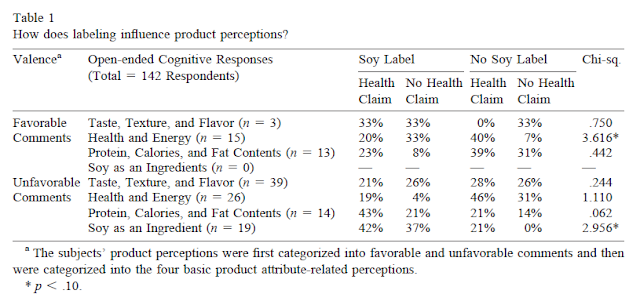This is a brief follow-up to my previous post highlighting some apparent cases of duplicate publication from the Food and Brand Lab. In that post, we saw apparently duplication of pieces of articles within other articles, an article within a book chapter, and a whole book chapter in two books at once.
There was even what looked like duplicate publication of the same results in two different studies (with different samples of participants). However, the lead author appears to be claiming here that this apparent duplication was nothing of the sort, because what happened was that " a master’s thesis was intentionally expanded upon through a second study which offered more data that affirmed its findings with the same language, more participants and the same results".
Today I found another case of duplicate publication, this time with the same method, number and description of participants, and tables of results. I wonder if the lead author will again apparently claim that everything happened exactly the same way twice.
The articles in question are:
Wansink, B., Park, S. B., Sonka, S., & Morganosky, M. (2000). How soy labeling influences preference and taste. International Food and Agribusiness Management Review, 3, 85–94. http://dx.doi.org/10.1016/S1096-7508(00)00031-8
Wansink, B., & Park, S.-B. (2002). Sensory suggestiveness and labeling: Do soy labels bias taste? Journal of Sensory Studies 17, 483–491. http://dx.doi.org/10.1111/j.1745-459X.2002.tb00360.x
Here is the (by now traditional) "Christmas tree" illustration of the similarities, with the 2000 article on the left and the 2002 article on the right. About 1,200 of the 2,200 words in the 2002 article have been copied more or less verbatim from the earlier article.
The samples appear to be identical:
Intriguingly, the 2002 article contains this sentence in the acknowledgements: "Thanks also to Steven T. Sonka and Michelle Morganosky for assistance on the original version of this project" (p. 483). Sonka and Morganosky were the two authors on the first article who were not listed as authors on the second. Presumably any words they wrote did not make it through the copy-paste operation that seems to have been used to prepare the 2002 article.
It seems that International Food and Agribusiness Management Review closed down in 2002, but the Journal of Sensory Studies is still going; indeed, this lab published one of the now-infamous "pizza papers" there in 2014.
As usual, all of the relevant files for this post are available here.
There was even what looked like duplicate publication of the same results in two different studies (with different samples of participants). However, the lead author appears to be claiming here that this apparent duplication was nothing of the sort, because what happened was that " a master’s thesis was intentionally expanded upon through a second study which offered more data that affirmed its findings with the same language, more participants and the same results".
Today I found another case of duplicate publication, this time with the same method, number and description of participants, and tables of results. I wonder if the lead author will again apparently claim that everything happened exactly the same way twice.
The articles in question are:
Wansink, B., Park, S. B., Sonka, S., & Morganosky, M. (2000). How soy labeling influences preference and taste. International Food and Agribusiness Management Review, 3, 85–94. http://dx.doi.org/10.1016/S1096-7508(00)00031-8
Wansink, B., & Park, S.-B. (2002). Sensory suggestiveness and labeling: Do soy labels bias taste? Journal of Sensory Studies 17, 483–491. http://dx.doi.org/10.1111/j.1745-459X.2002.tb00360.x
Here is the (by now traditional) "Christmas tree" illustration of the similarities, with the 2000 article on the left and the 2002 article on the right. About 1,200 of the 2,200 words in the 2002 article have been copied more or less verbatim from the earlier article.
The samples appear to be identical:
Of the 155 subjects who participated in the experiment, 45% were homemakers from the Midwest (average age of 31.2; 74.3% female) who received $6 donation for their participation, and 55% were undergraduate students (average age of 20.3; 52.4% female) from 11 different states and 8 different countries who received course credits for their participation. (Wansink et al., 2000, p. 87)
Of 155 participants who participated in the experiment 45% were meal-planners and local adults in the central Illinois area (ages 22 to 45) who received $6 donation for their participation, and 55% were undergraduate students at the University of Illinois (ages 17 to 21) who received course credit in exchange for their participation. (Wansink et al., 2002, p. 485)The tables of results are basically identical, at least to the extent that they occur in both articles. Table 1 of both articles is the same except for the order of the items and the number of reported decimal places of the test statistics. Tables 2a and 2b of the 2000 article correspond to the Tables 2 and 3 of the 2002 article, except that each of those tables only has six items in the latter version instead of 10 in the original. Table 3 of the 2000 article is not re-used in the 2002 article. Interested readers can look this up in detail in the articles, but for illustration here is Table 1 from each article (2000 first):
Intriguingly, the 2002 article contains this sentence in the acknowledgements: "Thanks also to Steven T. Sonka and Michelle Morganosky for assistance on the original version of this project" (p. 483). Sonka and Morganosky were the two authors on the first article who were not listed as authors on the second. Presumably any words they wrote did not make it through the copy-paste operation that seems to have been used to prepare the 2002 article.
It seems that International Food and Agribusiness Management Review closed down in 2002, but the Journal of Sensory Studies is still going; indeed, this lab published one of the now-infamous "pizza papers" there in 2014.
As usual, all of the relevant files for this post are available here.



thank you for information.. i like it.. thank you..!!1
ReplyDelete